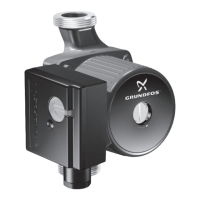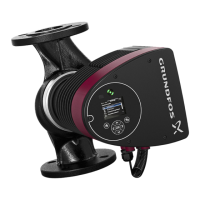7.2.3 Priming the product in open systems where the liquid
level is below the pump inlet
1. If an isolating valve is fitted on the inlet side of the pump, the
valve must be fully open.
2. Close the isolating valve in the outlet pipe, and tighten the
priming and drain plugs.
TM085822
Drain plug (E), priming and venting plug (M)
3. Connect a manual venting pump with the funnel instead of a
priming device.
4. Install a slide valve between the venting pump and the
centrifugal pump in order to protect the venting pump against
excessive pressure.
5. Once the slide valve at the manual venting pump has been
opened, vent the inlet pipe using short, rapid pump strokes until
the liquid runs out on the outlet side.
6. Close the valve at the venting pump.
7.3 Checking the direction of rotation
The pump must be filled with liquid when checking the
direction of rotation.
The correct direction of rotation is shown by arrows on the pump
housing. See the figure below.
M is priming plug (venting plug), E is drain plug.
1. Check the direction of rotation by watching the motor fan
rotation.
2. Turn the motor on for a brief while to ensure that the direction of
rotation is correct as indicated by the arrow cast into the pump
housing.
This should only be done for three-phase motors.
3. If the direction of rotation is incorrect, interchange two wires at
the motor starter terminals T1 and T2.
Use extreme caution to ensure that motors are turned on
only briefly when determining proper direction of rotation.
7.4 Starting up the pump
1. Fully open the isolating valve on the inlet side of the pump and
leave the isolating valve on the outlet side almost closed.
2. Start the pump.
3. Vent the pump during startup by loosening the air vent screw in
the pump head or pump head cover until a steady stream of
liquid runs out of the vent hole.
TM085823
Position of vent screw (A)/plug
WARNING
Escaping liquid
Death or serious personal injury
‐ Pay attention to the orientation of the vent hole to
ensure that the escaping liquid does not cause
personal injury or damage to the motor or other
components.
‐ In hot-liquid installations, pay special attention to
the risk of personal injury caused by scalding hot
liquid.
‐ In cold-liquid installations, pay special attention to
the risk of personal injury caused by cold liquid.
4. When the pipes have been filled with liquid, slowly open the
isolating valve on the outlet side until it is fully open.
5. Check the overload by measuring the motor current
consumption and comparing the value to the rated current
stated on the motor nameplate. In case of overload, throttle the
valve on the outlet side until the motor is no longer overloaded.
If the pump is fitted with a motor with an output
selected on the basis of a specific maximum flow rate,
the motor may be overloaded if the differential
pressure is lower than anticipated.
6. Always measure the motor current consumption during startup.
At the moment of startup, the input current of the
pump motor is up to six times higher than the full-load
current stated on the motor nameplate.
23
English (US)

